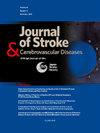Changes in fatigue after first-ever ischemic stroke and their associations with changes in physical fitness, body composition, and physical activity
IF 2
4区 医学
Q3 NEUROSCIENCES
Journal of Stroke & Cerebrovascular Diseases
Pub Date : 2025-03-28
DOI:10.1016/j.jstrokecerebrovasdis.2025.108297
引用次数: 0
Abstract
Objectives
The objectives of the present study were 1) to describe changes in fatigue from 3 to 12 months post-stroke and compare different patterns of fatigue changes with respect to concurrent changes in physical fitness, body composition, and activity levels, and 2) to explore whether changes in fatigue are associated with changes in physical fitness, body composition, and physical activity levels in patients recovering from first-ever ischemic stroke.
Materials and methods
In this longitudinal observational study, we assessed 72 patients (mean age 62 years, 36 % females) at 3 and 12 months after first-ever ischemic stroke. Fatigue was measured with the 7-item Fatigue Severity Scale. Physical fitness, body composition and physical activity were assessed using cardiopulmonary exercise testing, physical function tests, Dual-energy X-ray Absorptiometry, and accelerometers.
Results
Fatigue levels was stable between 3 and 12 months post-stroke in 44 (61 %) patients, decreased in 14 (19 %), and increased in another 14 (19 %). Patients with increased fatigue levels showed a greater decrease in cardiorespiratory fitness, as measured directly by peak oxygen uptake, compared to those with decreased fatigue. Robust regression analysis, adjusted for age and sex, indicated that each kilogram of lean body mass gained from 3 to 12 months post-stroke was significantly associated with a 0.3-point reduction in fatigue during the same timeframe (B= -0.32; 95 %CI [-0.51, -0.12]).
Conclusion
There was considerable individual variation in changes to fatigue, physical fitness, body composition, and physical activity levels between 3 and 12 months following a first-ever ischemic stroke. Increased fatigue was linked to a greater concurrent decline in cardiorespiratory fitness, while lean body mass was associated with decreases in fatigue.
首次缺血性中风后的疲劳变化及其与身体健康、身体成分和身体活动变化的关系
目的:本研究的目的是:1)描述脑卒中后3 - 12个月的疲劳变化,并比较不同的疲劳变化模式与身体健康、身体成分和活动水平的同时变化;2)探索首次缺血性脑卒中恢复患者的疲劳变化是否与身体健康、身体成分和身体活动水平的变化有关。材料和方法:在这项纵向观察研究中,我们评估了72例患者(平均年龄62岁,36%女性)在首次缺血性卒中后的3个月和12个月。疲劳采用7项疲劳严重程度量表进行测量。通过心肺运动测试、身体功能测试、双能x线吸收仪和加速度计评估身体健康、身体成分和身体活动。结果:44例(61%)患者中风后3 - 12个月的疲劳水平稳定,14例(19%)患者疲劳水平下降,另外14例(19%)患者疲劳水平升高。与疲劳程度降低的患者相比,疲劳程度增加的患者心肺健康度下降幅度更大,这是由峰值摄氧量直接测量的。经年龄和性别调整后的稳健回归分析表明,中风后3至12个月每增加一公斤瘦体重与同一时间段内疲劳程度降低0.3点显著相关(B= -0.32;95%ci[-0.51, -0.12])。结论:首次缺血性卒中后3 - 12个月内,患者在疲劳、体能、身体成分和身体活动水平方面存在相当大的个体差异。疲劳感的增加与心肺功能的同时下降有关,而瘦体重与疲劳感的减少有关。
本文章由计算机程序翻译,如有差异,请以英文原文为准。
求助全文
约1分钟内获得全文
求助全文
来源期刊

Journal of Stroke & Cerebrovascular Diseases
Medicine-Surgery
CiteScore
5.00
自引率
4.00%
发文量
583
审稿时长
62 days
期刊介绍:
The Journal of Stroke & Cerebrovascular Diseases publishes original papers on basic and clinical science related to the fields of stroke and cerebrovascular diseases. The Journal also features review articles, controversies, methods and technical notes, selected case reports and other original articles of special nature. Its editorial mission is to focus on prevention and repair of cerebrovascular disease. Clinical papers emphasize medical and surgical aspects of stroke, clinical trials and design, epidemiology, stroke care delivery systems and outcomes, imaging sciences and rehabilitation of stroke. The Journal will be of special interest to specialists involved in caring for patients with cerebrovascular disease, including neurologists, neurosurgeons and cardiologists.
 求助内容:
求助内容: 应助结果提醒方式:
应助结果提醒方式:


